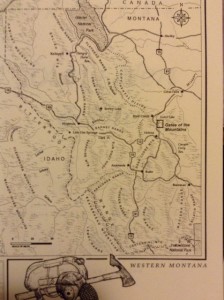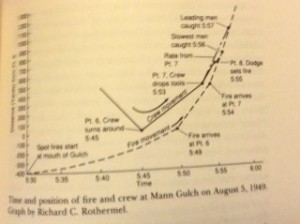I recently read Young Men and Fire, a book written by Norman Maclean. This is a  nonfiction book about a massive fire in Mann Gulch which is close to the Gates of the Mountains in the Missouri River Canyon between Helena and Great Falls, Montana.
nonfiction book about a massive fire in Mann Gulch which is close to the Gates of the Mountains in the Missouri River Canyon between Helena and Great Falls, Montana.
On August 5, 1949, a crew of fifteen of the U. S. Forest Service’s elite new airborne firefighters, the Smokejumpers, steped into the sky to fight the fire. Less than an hour after their jump, all but three were dead or mortally burned. Haunted by these deaths for more than forty years, Norman Maclean puts back together the scattered pieces of this tragedy.
The few facts about the fire that came out in the early fifties are stated in short order, the majority of the book tells about … “Maclean’s search for the truth of what happened, and an exploration of his own mortality becomes more compelling than his journey into the heart of the fire. His description of the conflagration terrifies, but it is his battle with words, his effort to turn the story of the 15 men into tragedy makes this book classic.”
From New York Time Book Review Editor’s Choice, Best Book of 1992.
Maclean was born in Iowa in 1902 and grew up in Missoula, MT. He worked for many years in logging camps and for the U. S. Forestry Service, then began his academic career. His writing is captivating, and his book, A River Runs Through It and other Stories, was published in 1976. Young Men and Fire wasn’t originated as a book until Maclean was 74, and was finished and edited by friends and family after his death in 1990. The book merged all the lives he would live; woodsman, firefighter. scholar, teacher, and storyteller.
The picture summarizes the tragic events that happened on that day in 1949 and shows time and position of the fire and smoke jumpers. In the words of Maclean, “Drawn along axes of time and distance is one line depicting the course of the fire and one depicting the course of the men, and where there is a convergence of the two, graphically speaking, is the tragic conclusion of the Mann Gulch story; the two lines converging to this conclusion constitute the plot. Along each line are numbers which are turning points in the race between men and fire, and if the lines are viewed as a race the numbers mark off legs of the race, if they also have religious significance they are stations of the cross, and if they have literary significance they mark off acts of drama. If it is drama it has the same old five acts of traditional drama, but the acts are much shorter, possibly because modern wildfire allows no time for soliloquies.”
I originally bought the book in 1994, because I went to college in Helena and often went up to the Missouri River canyon to enjoy it’s natural beauty and even camped in a canyon close to Mann Gulch. I didn’t read more than the first few chapters then, but picked it up lately and read the full book. I am writing this blog entry because of the relevance to woods, logging, and fires, and to the history of concepts of burn days, fire dangers in wooded and open prairie areas, which should be familiar to many Californians today. In reading the book, I found that all of these concepts (e. g., how do you determine that fire danger in a wooded area? ) were developed by the U.S. Forest Service as a result of the Mann Gulch fire and the persistent questioning of Maclean over the years. In addition, they learned some techniques to protect fire fighters and in particular, smokejumpers from such tragedies. From 1949 to 1994, no deaths occurred. On July 4, 1994, 52 smokejumpers and other fire fighters were fighting a seemingly minor fire in Colorado that suddenly erupted and in a matter of a few minutes, 14 were dead. Lessons from the Mann Gulch fire allowed the survival of 38 and a significant number of structures. Analysis of the Colorado tragedy lead to, hopefully, more valuable lessons to protect lives. One thing clearly happened— that analysis occurred quite soon as opposed to how the U. S. Forest Service reacted in 1949 when they tried to bury and ignore that earlier fire. Maclean offers his explanation for that behavior in his book.
But, beyond the analysis if the tragic deaths of 13 smokejumpers, Maclean also addresses questions we all are (or should be) trying to answer.. In Maclean’s last words in this book..
“I, an old man, have written this fire report. Among other things, it is important to me, as an exercise for old age, to enlarge my knowledge and spirit so I can accompany young men whose lives I might have lived on their way to death. I have climbed where they have climbed, and in my time I have fought fire and inquired into it’s nature. In addition, I have lived to get a better understanding of myself and those close to me, many of them now dead. Perhaps it is not odd, at the end of this tragedy where nothing much was left of the elite who came from the sky but courage struggling for oxygen, that I have often found myself thinking of my wife on her brave and lonely way to death.”
This book should be read by those of us interested in the history of logging and the effects of fires in dry, wooded canyon areas.
